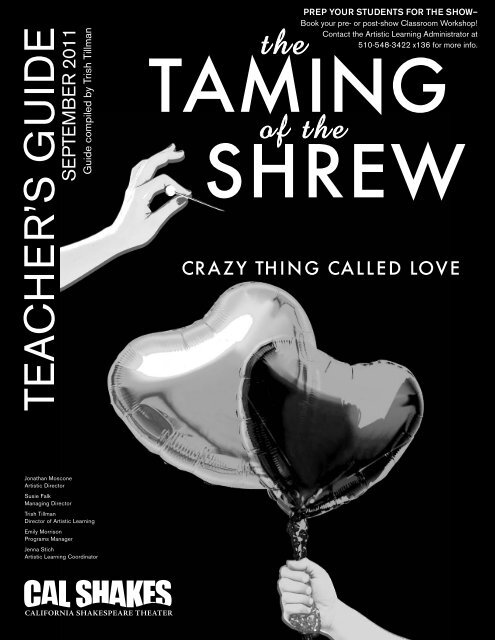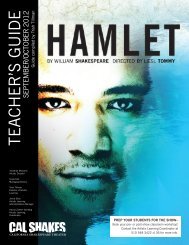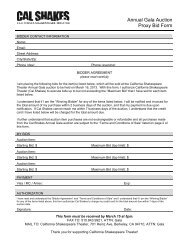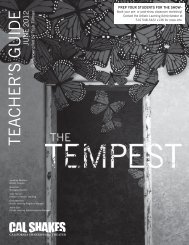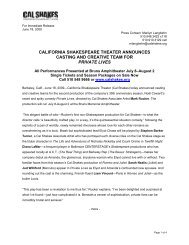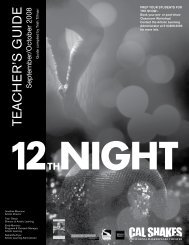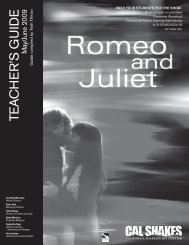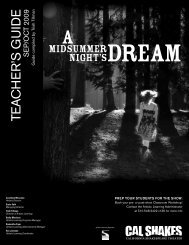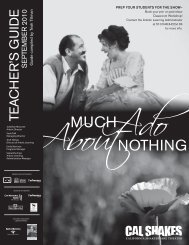TEA C H E R'S G U ID E - California Shakespeare Theater
TEA C H E R'S G U ID E - California Shakespeare Theater
TEA C H E R'S G U ID E - California Shakespeare Theater
You also want an ePaper? Increase the reach of your titles
YUMPU automatically turns print PDFs into web optimized ePapers that Google loves.
<strong>TEA</strong>CHER’S GU<strong>ID</strong>E<br />
SEPTEMBER 2011<br />
Guide compiled by Trish Tillman<br />
PREP YOUR STUDENTS FOR THE SHOW–<br />
Book your pre- or post-show Classroom Workshop!<br />
Contact the Artistic Learning Administrator at<br />
510-548-3422 x136 for more info.<br />
TAMING<br />
SHREW<br />
CRAZY THING CALLED LOVE<br />
Jonathan Moscone<br />
Artistic Director<br />
Susie Falk<br />
Managing Director<br />
Trish Tillman<br />
Director of Artistic Learning<br />
Emily Morrison<br />
Programs Manager<br />
Jenna Stich<br />
Artistic Learning Coordinator<br />
- 1 -
IN THIS GU<strong>ID</strong>E:<br />
1. Cal Shakes Overview<br />
a. Cal Shakes’ Mission and Funders.................................................................3<br />
b. Artistic Learning Programs at Cal Shakes..................................................4<br />
2. The Taming of the Shrew Overview<br />
a. A Note to Teachers...........................................................................................6<br />
b. Plot Summary.....................................................................................................7<br />
c. Who’s Who: The Actors..................................................................................8<br />
d. Who’s Who: The Characters/ Character Map...........................................11<br />
e. Seeing the Play: Before and After.................................................................12<br />
f. <strong>Shakespeare</strong>’s Language: Word!...................................................................13<br />
3. The Taming of the Shrew: “Crazy Thing Called Love”<br />
a. Crazy Thing Called: You Don’t Like Someone, but Maybe You Do ......15<br />
b. Crazy Thing Called: A Shrew ........................................................................16<br />
4. Elizabethan Culture Overview<br />
a. William <strong>Shakespeare</strong>: A Mysterious Life......................................................18<br />
b. Go Girls!.............................................................................................................19<br />
5. Resources<br />
a. The Taming of the Shrew on Film.................................................................21<br />
<br />
b. Additional Resources: Books and Internet.................................................22<br />
6. Classroom Activity Guide<br />
a. Cal Shakes’ Mission and Funders.................................................................24<br />
b. Social Networking Character Study: “Shakesbook” ...............................25<br />
c. Dear Diary...........................................................................................................29<br />
d. Twittering Shrews.............................................................................................30<br />
e. Shrew Remix......................................................................................................31<br />
f. The Dating Game: Shrew Style......................................................................33<br />
g. Make it Work: <strong>Shakespeare</strong>’s Runway........................................................34<br />
h. Musical Interlude...............................................................................................37<br />
i. Brush Up Your <strong>Shakespeare</strong> reference sheet..................................39<br />
j. Cal Shakes Critique: Elementary and Middle School................................40<br />
k. Cal Shakes Critique: Middle and High School...........................................41<br />
GU<strong>ID</strong>E CREDITS<br />
Editor: Trish Tillman<br />
Contributors: Christianne Bakewell, Sarah Benjamin, Jenna Grossman, Trish Tillman<br />
Copy Editor: Stefanie Kalem<br />
Layout & Graphics: Ilsa Brink<br />
- 2 -
CAL SHAKES’ MISSION<br />
AND FUNDERS<br />
OUR MISSION<br />
We strive for everyone, regardless of age, circumstance, or background, to discover and express the<br />
relevance of <strong>Shakespeare</strong> and the classics in their lives by:<br />
• Making boldly imagined and deeply entertaining interpretations of <strong>Shakespeare</strong> and the classics.<br />
• Providing in-depth, far-reaching creative educational opportunities.<br />
• Bringing disparate communities together around the creation of new American plays inspired<br />
by classic literature.<br />
OUR FUNDERS AND SPONSORS<br />
Our Student Discovery program for The Taming of the Shrew is part of <strong>Shakespeare</strong> for a New Generation, a national<br />
program of the National Endowment for the Arts in cooperation with Arts Midwest.<br />
Artistic Learning programs are also underwritten by generous support from the Bank of America Foundation, Dale<br />
Family Fund, Dodge & Cox, Sidney E. Frank Foundation, Walter & Elise Haas Fund, The Thomas J. Long Foundation,<br />
The Drs. Ben & A. Jess Shenson Foundation at The San Francisco Foundation, The Morris Stulsaft Foundation, and<br />
numerous donors to our annual Gala Fund-a-Need campaign.<br />
PRESENTING PARTNER<br />
SEASON PARTNER<br />
PRODUCTION PARTNER<br />
PROGRAM PARTNER<br />
SEASON UNDERWRITERS<br />
<strong>California</strong> <strong>Shakespeare</strong> <strong>Theater</strong><br />
701 Heinz Avenue, Berkeley, CA 94710<br />
510.548.3422 • www.calshakes.org<br />
- 3 -
ARTISTIC LEARNING PROGRAMS<br />
AT CAL SHAKES<br />
The vision of the Artistic Learning department of Cal Shakes is to become a leading Bay Area<br />
citizen, creating a culture of lifelong learners and nourishing imaginations in preparation for the<br />
work of life.<br />
Cal Shakes offers a variety of theater programs taught by theater professionals throughout the<br />
school year and summer.<br />
IN-SCHOOL ARTIST RES<strong>ID</strong>ENCIES<br />
With innovative curriculum, Cal Shakes brings working artists into the schools to teach<br />
theater arts to develop students’ intellectual and social skills. We work with classroom<br />
teachers to choose the text—<strong>Shakespeare</strong> or otherwise—and to align curriculum and methods<br />
in conjunction with the classroom teacher’s goals. All residencies consist of 8–10 hours of<br />
instruction over several weeks.<br />
STUDENT DISCOVERY MATINEES (Field trips)<br />
Our well-rounded approach to Student Matinees consists of multiple offerings, including this free<br />
Teacher/Student Guide, optional pre- and post-show classroom visits by teaching artists, a lively<br />
pre-performance engagement at the theater, and a Q&A session with actors immediately following<br />
the show. This multi-pronged approach offers a unique opportunity for students to develop a lasting<br />
appreciation of theater and of <strong>Shakespeare</strong> through dynamic presentation and the experience of a<br />
live work of art.<br />
<strong>TEA</strong>CHER’S GU<strong>ID</strong>ES INCLUDING STUDENT ACTIVITIES<br />
This teaching and student activity guide is available for each <strong>Shakespeare</strong> Main Stage production.<br />
It is available free of charge to all classrooms regardless of whether or not a class attends a<br />
Student Discovery Matinee.<br />
AFTER SCHOOL CLASSES After school programs are a popular offering, exploring <strong>Shakespeare</strong><br />
as well as such aspects of theater as acting, physical comedy, and improvisation. First grade and<br />
up.<br />
SUMMER SHAKESPEARE CONSERVATORIES<br />
Cal Shakes hosts Summer <strong>Shakespeare</strong> Conservatories in which students study with professional<br />
Cal Shakes actors and artists. Scholarships are available. Students return year after year to<br />
experience the joy of working intensely in theater fundamentals such as acting, improvisation, stage<br />
combat, and voice, culminating in a production of a <strong>Shakespeare</strong> play in original language.<br />
For more information or to register for any of our programs, please<br />
call the Artistic Learning Coordinator at 510.548-3422 x136, or email<br />
learn@calshakes.org.<br />
- 4 -
TAMING<br />
SHREW<br />
OVERVIEW<br />
- 5 -
A NOTE TO<br />
<strong>TEA</strong>CHERS<br />
“The first and most important lesson… is that there are no rules<br />
about how to do <strong>Shakespeare</strong>, just clues. Everything is negotiable.”<br />
Antony Sher and Greg Doran in Woza <strong>Shakespeare</strong>! (1996),<br />
on training in the Royal <strong>Shakespeare</strong> Company<br />
Welcome! We are thrilled to have you and your students join us for this season’s Student<br />
Discovery Matinee production of The Taming of the Shrew. Our goal is to engage students with<br />
the work on a variety of levels through the live performance and the activities in this Teacher’s<br />
Guide.<br />
This guide, The Taming of the Shrew: Crazy Thing Called Love, is intended to help you guide<br />
your students through this particularly challenging story of how one couple finds each other,<br />
despite the myriad of obstacles the world puts in their way.<br />
The difficulty in this play for a 21st-century audience is mainly that the play’s title and the plot<br />
seem to state firmly that a woman’s place is to be subservient to a man, and any woman who<br />
does not conform to this behavior pattern is worthy only of being called names. A shrew is a<br />
small mammal, about the size of mouse, known not only for its particularly aggressive behavior,<br />
but also for the fact that some species are actually venomous. Although Katherine’s behavior<br />
is clearly aggressive at times; unfortunately, the comparison between an unconventional,<br />
opinionated woman and a vicious animal comes all too easily, even today.<br />
In Elizabethan times this was not an unusual way to view women; in modern times,<br />
the world seems to demand conformity to a certain, almost unattainable beauty<br />
standard. In our production, director Shana Cooper highlights <strong>Shakespeare</strong>’s case that<br />
Petruchio and Katherine must break the bonds of conventionality to come together<br />
in an authentically loving, respectful, playful relationship. This is a quintessential<br />
struggle for us all, especially young people looking for identity through contemporary<br />
culture.<br />
Enjoy!<br />
The Cal Shakes Artistic Learning Department<br />
The Taming of the Shrew OVERVIEW<br />
- 6 -
PLOT SUMMARY:<br />
THE TAMING OF THE SHREW<br />
Katherine and Bianca are sisters, the wealthy daughters of the widower Baptista. Bianca is<br />
younger, nicer, and more date-able than her sister Katherine, who is known as a “shrew”—in<br />
other words, a woman of very ill temper. Frustrated and eager to get Katherine out of the house,<br />
Baptista declares that Bianca will not wed until Katherine, too, has tied the knot. In protest,<br />
Katherine declares that she will not marry.<br />
Hope for Baptista arrives in the form of an equally “difficult” person Petruchio, who—appearing<br />
on the scene with his complaining servant, Grumio, in tow—hears of Katherine’s wealth and<br />
availability. He decides to take on the challenge of convincing her to get married—to him.<br />
Petruchio and Katherine’s first meeting goes poorly. Fighting him every way she can, Katherine<br />
refuses to marry Petruchio. But no matter which way she turns, Petruchio matches her every step.<br />
Despite her protests, they become engaged.<br />
On the day of the wedding, Petruchio, in the first of his “lessons” for Katherine, arrives late to<br />
their wedding, dressed in strange clothing, to upset Katherine and her expectations of what<br />
a wealthy and upstanding wedding should be. After they are married, Petruchio insists that<br />
Katherine and he return immediately to his home instead of celebrating with her family.<br />
Meanwhile, Lucentio, a young man who has instantly fallen in love with Bianca, disguises himself<br />
as a tutor to gain time with her. Another two men court Bianca: Hortensio (a friend of Petruchio)<br />
and Gremio, an old man. Hortensio also poses as a tutor, attempting to teach Bianca music<br />
while Lucentio teaches her Latin. But Lucentio is really just flirting with her through whispered<br />
conversations, and clearly gains Bianca’s favor. Eventually, near the end of the play, Hortensio<br />
concedes that Lucentio is the victor.<br />
When Petruchio and his new bride arrive at his home, Petruchio rejects the dinner prepared for<br />
them and sends Katherine to bed hungry. Petruchio continues in this vein, refusing to give her<br />
food, rest, and new clothes; during an exhausting trip back to her father’s home, Katherine finally<br />
gives in and agrees to do whatever Petruchio says.<br />
In the meantime, Lucentio and Bianca have secretly married. Hortensio, likewise, has married<br />
a wealthy widow. Petruchio and Katherine arrive in Padua and Baptista holds a banquet for<br />
the newlyweds. Once the wives have left the table, Petruchio offers the husbands a bet to see<br />
which of the new wives is most obedient. Each husband in turn sends for his wife to return to the<br />
table. Lucentio sends for Bianca who refuses, stating she is too busy. Hortensio then sends for<br />
his wife who sends word back he should come to her. When Petruchio sends for Katherine she<br />
returns immediately. He then sends her to fetch the other two wives. She does and, on her return,<br />
instructs the assembly on the duties of a wife.<br />
The Taming of the Shrew OVERVIEW<br />
- 7 -
WHO’S WHO: The Actors<br />
CAST<br />
Tranio<br />
A servant to Lucentio who disguises himself as Lucentio to<br />
barter with Baptista for Bianca’s hand.<br />
Dan Clegg*<br />
Baptista<br />
A very wealthy gentleman of Padua and the father of Bianca<br />
and Katherine.<br />
Rod Gnapp*<br />
Bianca<br />
Baptista’s younger daughter. Bianca has many suitors<br />
including Hortensio, Gremio, and Lucentio. She may not<br />
marry any of them until her older sister, Katherine, is married.<br />
Alexandra Henrikson*<br />
Grumio<br />
Servant to Petruchio.<br />
Vincentio<br />
Lucentio’s father, an old man.<br />
Dan Hiatt*<br />
*Denotes member of Actors’ Equity Association.<br />
The Taming of the Shrew OVERVIEW<br />
- 8 -
WHO’S WHO: The Actors<br />
CAST<br />
Petruchio<br />
A down-on-his-luck gentleman from Verona who decides to<br />
marry Katherine for her money.<br />
Slate Holmgren*<br />
Joan Mankin*<br />
Curtis<br />
One of Petruchio’s servants.<br />
Merchant<br />
A traveling salesman who assumes the role of Lucentio’s<br />
father, Vincentio.<br />
Widow<br />
A woman who has lost her husband; she marries Hortensio.<br />
Lucentio<br />
A young man from Pisa who disguises himself as a tutor<br />
to woo the fair Bianca. He is the son of Vincentio.<br />
Nicholas Pelczar*<br />
Katherine<br />
Older daughter of Baptista, Bianca’s sister—the “shrew.”<br />
Erica Sullivan*<br />
Note: Role assignments subject to change.<br />
The Taming of the Shrew OVERVIEW<br />
- 9 -
WHO’S WHO: The Actors<br />
CAST<br />
Gremio<br />
An old man and suitor to Bianca.<br />
Tailor<br />
A person who creates clothing for men.<br />
Danny Scheie*<br />
Hortensio<br />
A friend of Petruchio who is also a suitor to Bianca.<br />
Liam Vincent*<br />
Biondello<br />
A servant to Lucentio.<br />
Theo Black<br />
*Denotes member of Actors’ Equity Association.<br />
The Taming of the Shrew OVERVIEW<br />
- 10 -
WHO’S WHO:<br />
THE CHARACTERS<br />
The Taming of the Shrew OVERVIEW<br />
- 11 -
SEEING THE PLAY:<br />
BEFORE AND AFTER<br />
“Myself am moved to woo thee for my wife”<br />
–Petruchio, Act 2, scene 1<br />
Consider the following questions before and after the show.<br />
BEFORE Viewing the Play<br />
AFTER Viewing the Play<br />
Can you imagine why Kate acts<br />
the way she does?<br />
Do you think men and women are<br />
equal?<br />
Look for the ways Kate and Bianca<br />
are pressured by family and<br />
society.<br />
Look for how people use words<br />
to express themselves, especially<br />
when they are angry.<br />
As you watch the play, try to<br />
decide if this kind of story that<br />
would happen in real life.<br />
Do you think Katherine and Petruchio are really in<br />
love?<br />
What do you think <strong>Shakespeare</strong> is saying about<br />
marriage?<br />
Did the setting and costumes of the characters<br />
make sense to you?<br />
Which of the characters do you like best? Why?<br />
Does Katherine really change? How about<br />
Petruchio?<br />
Was anyone unfairly treated? If yes, why do you<br />
think that happened?<br />
Did you recognize any parts of this story from your<br />
own life? Do you know any people like these, or<br />
anyone that acts like this in a relationship?<br />
See the “Write Your Own Critique” page in the Activity Appendix for more ideas about what to watch for and how to<br />
write about your reactions after the show.<br />
The Taming of the Shrew OVERVIEW<br />
- 12 -
SHAKESPEARE’S LANGUAGE<br />
When asked the number-one challenge with <strong>Shakespeare</strong>’s works, modern-day audiences will almost always<br />
respond: “the language.” It’s true that the language does sound different to our ears and that <strong>Shakespeare</strong><br />
uses phrases we no longer use in our everyday speech. But think of this: There are phrases that we use today<br />
that would baffle <strong>Shakespeare</strong>, should he magically time-travel to this day and age. That’s because language<br />
(especially English) is constantly transforming.<br />
Can you match these original quotes from The Taming of the Shrew to their modern-day translations?<br />
No shame but mine. I must, forsooth, be forced<br />
To give my hand, opposed against my heart<br />
Unto a mad-brain rudesby, full of spleen<br />
Who wooed in haste and means to wed at leisure<br />
- Act 3, Sc. 2<br />
People who are better than you can handle<br />
me saying what I really feel. If you can’t<br />
deal with it, don’t listen.<br />
There’s small choice in rotten apples.<br />
-Act 1, Sc. 1<br />
If she do bid me pack, I’ll give her thanks,<br />
though she bid me stay by her a week:<br />
If she deny to wed, I’ll crave the day<br />
When I shall ask the banns and when be married.<br />
-Act 2, Sc. 1<br />
Moved! in good time: let him that moved you hither<br />
Remove you hence: I knew you at the first<br />
You were a moveable.<br />
-Act 2, Sc. 1<br />
Of all the men I’ve met, I’ve never found<br />
the one I really loved.<br />
If she tells me to get lost, I’ll say<br />
“thank you” and stay right here. If she<br />
says she won’t marry me, I’ll ask her<br />
when I should book the church for the<br />
wedding.<br />
Did he marry me to starve me?<br />
Everywhere else beggars find food<br />
and help, but not me.<br />
Be thou armed for some unhappy words.<br />
-Act 2, Sc. 1<br />
Get ready for some bad news.<br />
Of all the men alive<br />
I never yet beheld that special face<br />
Which I could fancy more than any other.<br />
-Act 2, Sc. 1<br />
You want to marry me? Too bad! Whoever<br />
brought you here should take you away<br />
now! When I first saw you I knew you were<br />
crazy.<br />
What, did he marry me to famish me?<br />
Beggars, that come unto my father’s door,<br />
Upon entreaty have a present alms;<br />
If not, elsewhere they meet with charity<br />
-Act 3, Sc. 3<br />
Your betters have endured me to say my mind,<br />
And if you cannot, best you stop your ears.<br />
-Act 4, Sc. 3<br />
I feel so stupid. I have to marry some idiotic,<br />
rude guy who has fun dating me but can’t bring<br />
himself to actually marry me.<br />
When you’re stuck with a bunch of bad<br />
choices, it’s like having a bunch of rotten<br />
fruit—nothing’s any good.<br />
See Brush Up Your <strong>Shakespeare</strong> on page 39.<br />
The Taming of the Shrew OVERVIEW<br />
- 13 -
CRAZY THING<br />
CALLED LOVE<br />
- 14 -
CRAZY THING CALLED:<br />
You Don’t Like Someone, But Maybe You Do<br />
Remember how, in elementary school, some kids showed that they liked someone by hitting<br />
them on the arm or doing something similar? Little children don’t know how to ask for positive<br />
attention, so they demand it with physical contact. Katherine and Petruchio seem to be stuck in<br />
that level of relating to each other. But <strong>Shakespeare</strong> shows us that they really do like each other<br />
by how their dialogue is written. Even though they act like enemies, <strong>Shakespeare</strong> shows us that<br />
these two are so well-matched, verbally, that everyone else in the play and the whole audience<br />
knows they are destined to be together, no matter how much they protest. In the following<br />
dialogue, note how each person picks up on the words (in bold) the other has used, using them<br />
to craft another insult:<br />
PETRUCHIO: Come, come, you wasp; i’ faith, you are too angry.<br />
KATHERINE : If I be waspish, best beware my sting.<br />
PETRUCHIO : My remedy is then, to pluck it out.<br />
KATHERINE : Ay, if the fool could find it where it lies.<br />
PETRUCHIO: Who knows not where a wasp does wear his sting? In his tail.<br />
KATHERINE : In his tongue.<br />
PETRUCHIO : Whose tongue?<br />
KATHERINE: Yours, if you talk of tails, and so farewell.<br />
PETRUCHIO: What, with my tongue in your tail?<br />
<strong>Shakespeare</strong> suggests that this couple is well-suited to one another by their shared ability to<br />
connect through the wordplay of matching and one-upmanship.<br />
For Students<br />
Do you know someone who tries to get someone’s attention by doing things like teasing,<br />
pretending to steal things from them, or just hanging around a lot?<br />
Write a six-line argument between Katherine and Petruchio using modern-day insults.<br />
Remember to keep it playful and fun—these characters really like each other.<br />
See Resources: Books and Internet on page 22 for a link to a Shakespearan insult page.<br />
See “Go Girls!” on page 19 for further information on women and Elizabethan culture.<br />
CRAZY THING CALLED LOVE<br />
- 15 -
CRAZY THING<br />
CALLED:<br />
“Katharine the curst! A title for a maid of all titles the worst.”<br />
—Grumio, Act 1, scene 2<br />
The difficulty with this play for a 21 st -century audience is mainly that the play’s title and the<br />
action of the plot appear to state that a woman’s place is to be subservient to a man, and that<br />
any woman who does not conform to this behavior pattern is to be put down. An example of<br />
this is that, throughout the course of the play, Katherine is likened to a shrew. A shrew is a small<br />
mammal, about the size of mouse, known for its particularly aggressive behavior; some species<br />
are actually venomous. Although Katherine’s actions are clearly aggressive at times, so are<br />
Petruchio’s. Unfortunately, the comparison between an unconventional, opinionated woman and a<br />
vicious animal still comes all too easily, even today.<br />
Our production takes the view that, although this was not an unusual way to view<br />
women in Elizabethan times, <strong>Shakespeare</strong> also saw that both Petruchio and Katherine<br />
have to grow up. The only way they can do this is to come together in an authentically<br />
loving, respectful, and playful relationship.<br />
For Students<br />
Make a note of some popular books or movies that have a sympathetic female as the main<br />
character.<br />
Look up articles on female politicians and how they are described in the media.<br />
Look up the Bechdel Test, which is a way to look at female characters in movies, in relation to<br />
men. It consists of three rules:<br />
1. It includes at least two women…<br />
2. who have at least one conversation...<br />
3. about something other than a man or men.<br />
There are a surprisingly number of films that do not pass this test, and several of the ones who do<br />
still portray women in an unattractive light, just as Katherine is. Why is this?<br />
Do you believe that Katherine is “tamed”? From your point of view, what do you think that means?<br />
Do you think people need to be taught lessons on how to live well? What do you think of<br />
Petruchio’s lessons?<br />
See “Go Girls!” on page 19 for further information on women and Elizabethan culture.<br />
CRAZY THING CALLED LOVE<br />
- 16 -
ELIZABETHAN CULTURE<br />
OVERVIEW<br />
- 17 -
WILLIAM SHAKESPEARE:<br />
A MYSTERIOUS LIFE<br />
“I will be free, even to the uttermost, as I please, in words.”<br />
—Katherine, Act 4, scene 3<br />
Sure, he’s one of the most highly regarded writers of all time. But the really interesting thing is that we don’t<br />
actually know if the man known as William <strong>Shakespeare</strong>—of Stratford-on-Avon, son of a glove-maker—was<br />
really the author of all the plays written under his name. A common argument is that a lower middle-class<br />
man such as <strong>Shakespeare</strong> could not have had sufficient education or knowledge of court matters to write<br />
so insightfully and profoundly of the human condition and of kings, much less use language so skillfully. Who<br />
could have written the plays? Frequently suggested are:<br />
• Queen Elizabeth,<br />
• The Earl of Oxford,<br />
• Sir Francis Bacon,<br />
• And a bunch of other playwrights writing under one name.<br />
Even his real birthday is unsure. (Birth records of the time are rare and unreliable.) <strong>Shakespeare</strong> was born on<br />
April 23, or maybe the 20th, or the 21st, or maybe even May 3. It’s pretty certain that it was in 1564, and that<br />
he was baptized on April 26. To add to the confusion, back in <strong>Shakespeare</strong>’s day there wasn’t actually such<br />
a thing as standard spelling—people spelled words as they sounded. Common spellings of “<strong>Shakespeare</strong>”<br />
include “Shakespere,” “Shackspeare,” and “Shakspeare.” Furthermore, only a few samples of handwriting are<br />
thought actually to be his—plays were copied out by actors and others in the theater company to carry for<br />
rehearsals.<br />
There are a few things about <strong>Shakespeare</strong>, however, that we do know for sure. A man known as William<br />
<strong>Shakespeare</strong> definitely was involved in the theater: His name is listed among the acting company known as<br />
the Lord Chamberlain’s Men in London, which was very popular with the people and with Queen Elizabeth.<br />
The company also built the famous Globe Theatre in London, which premiered most of <strong>Shakespeare</strong>’s plays.<br />
<strong>Shakespeare</strong> had a son named Hamnet who died young, and is thought to have inspired the name of Hamlet.<br />
<strong>Shakespeare</strong> had two other children: Hamnet’s twin, Judith; and another daughter, Susannah.<br />
Unfortunately, the <strong>Shakespeare</strong> line ended when his granddaughter Elizabeth died in 1670, having no children<br />
of her own. Therefore, there are no descendants who kept records of the time.<br />
<strong>Shakespeare</strong> is buried in the Holy Trinity Church in Stratford-upon-Avon, his birthplace. On this grave there is<br />
an inscription cursing anyone who dares to move his body from that final resting place. To this day his bones<br />
remain undisturbed.<br />
What do you think?<br />
For Students<br />
Look up the clues that people have collected about who <strong>Shakespeare</strong> was. Do you think there<br />
really was one man from Stratford-on-Avon who wrote all of the plays, or was the name used to<br />
cover up the real author(s)? Why would someone want to cover it up? Does any of this matter in<br />
the end?<br />
. ELIZABETHAN CULTURE OVERVIEW<br />
- 18 -
GO GIRLS!<br />
“I see a woman may be made a fool, if she had not a spirit to resist.”<br />
—Katherine, Act 3, scene 1<br />
In <strong>Shakespeare</strong>’s time, the decision to marry was in the hands of a girl’s father, because it<br />
was considered disrespectful for a daughter to communicate her own desires in the process.<br />
Furthermore, when a woman married, all of her personal property became the property of her<br />
husband. Elizabethans thought women needed a male caretaker (remember, females could<br />
not have careers). However, <strong>Shakespeare</strong> lived during the time of the Renaissance, which was<br />
a turbulent and exciting period of history in which many old and accepted ideas were being<br />
questioned, examined, and reinterpreted. <strong>Shakespeare</strong> is known for creating female characters<br />
that are just as complex, intelligent, and powerful as the males. Katherine is one of the primary<br />
examples of this.<br />
Just like Katherine, Queen Elizabeth herself—for whom the era was named—defied the<br />
expectations for women of her time. She never married because she realized early on that<br />
marriage meant loss of power. Even though the general opinion of the time was that women’s<br />
minds were weak and that a female head of state was “an offense against nature,” she ruled with<br />
great political skill and cunning.<br />
Politically, in the United States, a women’s right to vote came in 1920 with the 19th Amendment<br />
to the Constitution. Increased debate at that time about where a woman’s “place” is in society<br />
has continued through to this day, in matters of what professions women may enter, their role<br />
in raising children, and their pay in relation to men, to name only a few. The popularity of The<br />
Taming of the Shrew rests not only in the fact that it provides delightful comedy, but also in that<br />
it keeps us thinking about how men and women relate to each other.<br />
For Students: What about the ending?<br />
Katherine’s final monologue at the end of the play is famously controversial. Do you<br />
think she is truly saying that she now believes that a woman should be in all ways<br />
inferior to a man? Could there be any other meaning? Rewrite Katherine’s last<br />
monologue from your own point of view.<br />
ELIZABETHAN CULTURE OVERVIEW<br />
- 19 -
RESOURCES<br />
- 20 -
The Taming of the Shrew<br />
ON FILM<br />
The Taming of the Shrew is as popular onscreen as it is onstage. Many film versions are<br />
faithful adaptations and are named directly after the play; there are many more that employ<br />
vastly different titles and interpretations, or are simply inspired by the plot of The Taming<br />
of the Shrew. Many of these films update the play to a modern setting. Here’s a few of the<br />
most popular:<br />
Kiss Me Kate (1953)<br />
Directed by George Sidney<br />
Starring Kathryn Grayson and Howard Keel<br />
Musical based on the classic<br />
Taming of the Shrew (1967)<br />
Directed by Franco Zeffirelli<br />
Starring Elizabeth Taylor and Richard Burton<br />
A visually stunning but straightforward interpretation of <strong>Shakespeare</strong>’s tale<br />
Taming of the Shrew (1979)<br />
Directed by Kirk Browning<br />
Starring Fredi Olster and Marc Singer<br />
Commedia dell’arte telling of the classic, made for American television<br />
The Taming of the Shrew (2005)<br />
Starring Shirley Henderson and Rufus Sewell<br />
Modern telling set in London, England, made for British television, with Katherine<br />
a successful politician<br />
Ten Things I Hate About You (1999)<br />
Directed by Gil Junger<br />
Starring Heath Ledger and Julia Stiles<br />
Modern, teen-friendly, set in a high school<br />
Many of the films listed above can be seen, in part, on YouTube. Some examples you might want to look for<br />
include:<br />
“Kate Meets Petruchio” - American Conservatory <strong>Theater</strong>, 1976<br />
The Taming of the Shrew - animated versions<br />
The Taming of the Shrew - Backstage with director Peter Hinton (2008)<br />
The Taming of the Shrew - Lucy Peacock as Grumio (2008)<br />
The Taming of the Shrew: II, 2 - John Cleese<br />
RESOURCES<br />
- 21 -
BOOKS AND INTERNET<br />
(page 1 of 2)<br />
Teaching Resources for The Taming of the Shrew<br />
Folger <strong>Shakespeare</strong> Library: Folger.edu<br />
“Life in Elizabethan England”: Elizabethan.org/compendium; Teachit.co.uk/armoore/shakespeare; and<br />
Snaithprimary.eril.net/ttss.htm<br />
Activities on Shrew’s plot and character relationships: Collaborativelearning.org/muchadoplotrelationships.<br />
pdf (for Much Ado About Nothing, but can be adapted to any <strong>Shakespeare</strong> play)<br />
The Stratford Festival’s “Tools for Teachers: Stratfordfestival.ca/education/teachers.aspx?id=1096<br />
<strong>Shakespeare</strong> Resource Center’s “Elizabethan England”: Bardweb.net/England.html<br />
The Kennedy Center’s “The Poetics of Hip Hop”: Artsedge.kennedy-center.org/educators/lessons/<br />
grade9-12/Poetics_of_Hip_Hop.aspx<br />
<strong>Shakespeare</strong>an Insult Worksheet: Gallery.carnegiefoundation.org/collections/quest/collections/sites/<br />
divans-hutchinson_yvonne1/Yvonne%20scans/insultsheet.pdf<br />
<strong>Shakespeare</strong> retold: BBC.co.uk/drama/shakespeare<br />
A list of further Taming resources: <strong>Shakespeare</strong>help.com/taming.htm<br />
Women in Today’s Society: Bechdeltest.com; Commonsensemedia.org/advice-for-parents/battlingstereotypes-tips<br />
Books:<br />
Davis, James E., ed. Teaching <strong>Shakespeare</strong> Today: Practical Approaches and Productive Strategies. Urbana,<br />
Ill: National Council of Teachers of English, 1993.<br />
Crystal, David, and Crystal, Ben. The <strong>Shakespeare</strong> Miscellany. The Overlook Press, Peter Mayer Publishers,<br />
Inc. Woodstock and New York, 2005.<br />
Crystal, David, and Crystal, Ben. <strong>Shakespeare</strong>’s Words: A Glossary and Language Companion. Penguin<br />
Books, The Penguin Group. London, 2002.<br />
Papp, Joseph and Elizabeth Kirkland. <strong>Shakespeare</strong> Alive! New York, New York: Bantam Books, 1988.<br />
Epstein, Norrie. The Friendly <strong>Shakespeare</strong>: A Thoroughly Painless Guide to the Best of the Bard. New York,<br />
New York: Penguin Books, 1993<br />
Asimov, Isaac. Asimov’s Guide to <strong>Shakespeare</strong>. New York, New York: Random House, 1970.<br />
Bender, Michael. All the World’s a Stage: A Pop-Up Biography of William <strong>Shakespeare</strong>. San Francisco:<br />
Chronicle Books, 1999.<br />
Foster, Cass and Lynn G. Johnson. <strong>Shakespeare</strong>: To Teach or Not To Teach. Grades three and Up.<br />
Scottsdale, AZ: Five Star Publications, 1992.<br />
Garfield, Leon. <strong>Shakespeare</strong> Stories. Boston: Houghton Mifflin Company, 1998.<br />
Morley, Jacqueline and John James. <strong>Shakespeare</strong>’s Theatre: The Inside Story. East Sussex, London: Simon<br />
and Schuster Young Books, 1994.<br />
RESOURCES<br />
- 22 -
CLASSROOM<br />
ACTIVITY GU<strong>ID</strong>E<br />
September 2011<br />
Jonathan Moscone<br />
Artistic Director<br />
Susie Falk<br />
Managing Director<br />
Trish Tillman<br />
Director of Artistic Learning<br />
Emily Morrison<br />
Programs Manager<br />
Jenna Stich<br />
Artistic Learning Coordinator<br />
PREP YOUR STUDENTS FOR THE SHOW–<br />
Book your pre- or post-show Classroom Workshop!<br />
Contact the Artistic Learning Administrator at<br />
510-548-3422 x136 for more info.<br />
CRAZY THING CALLED LOVE<br />
Note to Teachers: This guide was created as a supplement for teachers preparing students to see <strong>California</strong><br />
<strong>Shakespeare</strong> <strong>Theater</strong>’s production The Taming of the Shrew. Worksheets are designed to be used individually<br />
or in conjunction with others throughout the guide. While we realize that no aspect of this guide fully outlines a<br />
course for meeting a subject area’s standards, discussion questions and topics are devised to address certain<br />
aspects of <strong>California</strong> state standards. The activities here can be minimally reproduced for educational, nonprofit<br />
use only. All lessons must be appropriately credited.<br />
There are many excellent lesson plans for The Taming of the Shrew on the Internet. Please see our “Resources”<br />
page for links. This guide concentrates primarily on ideas that help students understand language, plot, and<br />
character through activities that get students on their feet and speaking.<br />
If you are interested in a <strong>California</strong> <strong>Shakespeare</strong> <strong>Theater</strong> Professional Development Workshop, which provides<br />
easy-to-learn tools for teachers to incorporate theater and arts education activities into <strong>California</strong> standards-based<br />
core curriculum, please contact the Artistic Learning Department at 510-548-3422 x136 or learn@calshakes.org.<br />
- 23 -
CAL SHAKES’ MISSION<br />
AND FUNDERS<br />
OUR MISSION<br />
We strive for everyone, regardless of age, circumstance, or background, to discover and express the<br />
relevance of <strong>Shakespeare</strong> and the classics in their lives by:<br />
• Making boldly imagined and deeply entertaining interpretations of <strong>Shakespeare</strong> and the classics.<br />
• Providing in-depth, far-reaching creative educational opportunities.<br />
• Bringing disparate communities together around the creation of new American plays inspired<br />
by classic literature.<br />
OUR FUNDERS AND SPONSORS<br />
Our Student Discovery program for The Taming of the Shrew if part of <strong>Shakespeare</strong> for a New Generation, a national<br />
program of the National Endowment for the Arts in cooperation with Arts Midwest.<br />
Artistic Learning programs are also underwritten by generous support from the Bank of America Foundation, Dale<br />
Family Fund, Dodge & Cox, Sidney E. Frank Foundation, Walter & Elise Haas Fund, The Thomas J. Long Foundation,<br />
The Drs. Ben & A. Jess Shenson Foundation at The San Francisco Foundation, The Morris Stulsaft Foundation, and<br />
numerous donors to our annual Gala Fund-a-Need campaign.<br />
PRESENTING PARTNER<br />
SEASON PARTNER<br />
PRODUCTION PARTNER<br />
PROGRAM PARTNER<br />
SEASON UNDERWRITERS<br />
<strong>California</strong> <strong>Shakespeare</strong> <strong>Theater</strong><br />
701 Heinz Avenue, Berkeley, CA 94710<br />
510.548.3422 • www.calshakes.org<br />
- 24 -
Have your students create a Facebook profile for a character from the play.<br />
Overview: Being able to empathize with fictional characters sheds light on our own personal<br />
situations, and recast the plot of the play in relevant terms.<br />
Grades: 6–12<br />
SOCIAL NETWORKING<br />
CHARACTER STUDY:<br />
Goal: To bring the characters of The Taming of the Shrew into a real-world context.<br />
Outcomes: Students will be able to use basic facts from the text to imaginatively enter into the<br />
thoughts, feelings, and motivations of fictional characters by creating a mock Facebook page.<br />
Activity: Familiarize students with the profile layout of a social networking site page, such as Facebook.<br />
(See following examples.<br />
1. Ask the students to fill in the profile with<br />
a. vital statistics<br />
b. likes and dislikes<br />
c. friends<br />
Note: Students should use information drawn from their knowledge of the play (for example,<br />
Petruchio seems to like to mess with people), filled out by their imaginations (for example,<br />
when Petruchio was a teenager he was always in trouble for playing practical jokes on the<br />
teacher).<br />
2. Profile photos may be drawn or cut out from magazines, or an actual photo of the student could<br />
be used and attached to the page. Remember, many actual Facebook profile pages do not have an<br />
actual photo of the person who made them—Facebook members sometimes choose a picture of<br />
something they feel represents them, e.g., a tree or a poster they like.<br />
3. Share the pages you have created in student pairs or in a group discussion.<br />
Reflection:<br />
• Name one thing you had to imagine about your character that you think is really interesting.<br />
• Was it easy to imagine beyond the play—for instance, what Grumio’s activities and interests might<br />
be? Or do you feel the play did not provide enough information? How so?<br />
• How easy was it to decide who your character’s friends are? Would your character ignore a friend<br />
request from other characters in the play? Why or why not?<br />
Extension exercise in writing dialogue:<br />
Beyond the basic profile information, a further way to extend the activity is to have the students write on<br />
each other’s profile “walls.” A wall is the area on a profile page where friends can write short messages<br />
to each other that are posted directly on the page for others to view.<br />
Note: Require the students to fill out the worksheet manually, rather than actually filling out a public<br />
profile online. If you can post their mock profile pages onto your school website or blog for students to<br />
fill out within the framework of this project, that would work as well, but false profiles in a public space<br />
should be actively discouraged. Student examples should show a deep understanding of the plot and<br />
qualities of the character. Some examples follow.<br />
ACTIVITY GU<strong>ID</strong>E<br />
<br />
- 25 -
shakesbook<br />
The Taming of the Shrew<br />
Bianca Minola<br />
SHOPPING!<br />
Studied Latin<br />
Married to/in a relationship with it’s complicated<br />
Write something...<br />
Friends (899)<br />
Share<br />
RECENT ACTIVITY<br />
Hortensio<br />
Bianca Minola<br />
SHOPPING!<br />
Katherine Minola<br />
Bianca wrote on Katherine Minola’s Wall<br />
Bianca wrote on Baptista Minola’s Wall<br />
Baptista<br />
Bianca and Lucentio are now friends<br />
Baptista Minola<br />
Bianca! Who is this young man!?<br />
Gremio<br />
Hortensio<br />
Bianca, what are you doing tonight?<br />
Want to go to dinner with me?<br />
Gremio<br />
Bianca, want to dine with me tonight?<br />
Bianca likes boys and high fashion<br />
ACTIVITY GU<strong>ID</strong>E<br />
<br />
- 26 -
shakesbook<br />
The Taming of the Shrew<br />
Katherine Minola (Kate)<br />
I officially hate men!<br />
Studied Lute<br />
Married to Petruchio<br />
Write something...<br />
Friends (2)<br />
Share<br />
RECENT ACTIVITY<br />
Bianca Minola<br />
Katherine Minola<br />
I officially hate men!<br />
Katherine Minola wrote on Petruchio’sWall<br />
Baptista<br />
Katherine went from “married” to “it’s complicated”<br />
Katherine is now listed as “married” to Petruchio<br />
Baptista Minola and Bianca Minola like this<br />
Hey sis! Congrats on the wedding!<br />
Now I get to get hitched! YAY!<br />
Lucentio, Hortensio, and Gremio like this<br />
Katherine is now friends with Petruchio<br />
Katherine likes nothing<br />
ACTIVITY GU<strong>ID</strong>E<br />
<br />
- 27 -
shakesbook<br />
The Taming of the Shrew<br />
Friends<br />
Share<br />
ACTIVITY GU<strong>ID</strong>E<br />
<br />
- 28 -
DEAR DIARY<br />
Overview: Writing a diary, blog, or journal entry from the perspective of one of the play’s characters<br />
creates empathy with fictional characters, sheds light on our own personal situations, and recasts the<br />
plot of the play in relevant terms.<br />
Grades: 6–12<br />
Goal: To bring the characters of The Taming of the Shrew into a real-world context.<br />
Outcomes: Students will be able to use facts from the text to imaginatively enter into the thoughts,<br />
feelings and motivations of fictional characters by writing a diary entry about an off-stage moment from<br />
the perspective of a character in the play.<br />
Activity:<br />
1. Ask the students to write a diary, blog, or journal entry from the point of view of a character in The<br />
Taming of the Shrew: describing a moment when that character is not seen onstage.<br />
2. Ask the students to choose a character and a moment to write about. Examples: What happens on<br />
Petruchio’s first journey with Grumio to Padua at the beginning of the play? Where is Katherine and<br />
what is she doing between her argument with Bianca and her meeting with Petruchio? What happens<br />
on the horseback journey to Petruchio’s house after the wedding? What is Petruchio doing that makes<br />
him so late for the wedding? What was the morning of the wedding day like in Baptista’s house?<br />
Think about: What is happening when the character is in this offstage situation? What is the character<br />
thinking and feeling?<br />
Reflection:<br />
-Name one thing you had to imagine about your character that you think is really interesting.<br />
-Was it easy to imagine beyond the play—for instance, what Bianca’s thoughts and impressions might<br />
be? Do you feel the play did not provide you with enough information? How so?<br />
-How easy was it to decide which character to write an entry for? Are there characters who you think<br />
might be more likely to keep a diary or blog?<br />
Extension Exercise:<br />
Do the same writing exercise, but have one student write about the same incident from multiple<br />
characters’ points of view. Alternatively, have many students describe the same incident from one<br />
character’s viewpoints.<br />
Instead of a written piece, do a vlog (video blog) from the point of view of one character, or featuring<br />
two characters talking about the incidents and expressing their opinions and feelings about what<br />
happened.<br />
ACTIVITY GU<strong>ID</strong>E<br />
<br />
- 29 -
THE TWITTERING<br />
OF THE SHREW<br />
Overview: Using the social network Twitter, have your students create a list of tweets from<br />
different characters, tracking their progress throughout the play. Have them go a step further to<br />
create dialogue between characters.<br />
Grades: 6-12<br />
Goal: To bring the characters of The Taming of the Shrew into a real-world context. To<br />
increase understanding of how the characters interact and feel towards one another.<br />
Outcomes: Students will be able to use specific facts and lines from the play to make clear<br />
the relationships between characters.<br />
Activity: Familiarize student with the layout of a twitter post—a tweet—and its character limit<br />
(140, including spaces).<br />
Reflection:<br />
1. Ask the students to create a Twitter name (also called a “handle”) for their character.<br />
2. Ask students to create a list of tweets that their character would post throughout the<br />
play.<br />
3. Have students create Twitter names for other characters in the play and have them<br />
talk to one another via Twitter. Examples:<br />
a. @Gremio: @Bianca4realz I will come to woo, my lady!<br />
b. @Hortensio93: I think not! Unless you plan to tutor her…<br />
c. @Lucentiodawg: Hmmm, is @Tranio thinking what I’m thinking?<br />
- Was it easy to decide what the characters’ Twitter names were? Did you try<br />
to make the Twitter names reflect something about the character?<br />
- Was it easy or fun to pick out lines from the play to use in a tweet?<br />
- Were some relationships easier to convey via tweets than others? Why?<br />
ACTIVITY GU<strong>ID</strong>E<br />
<br />
- 30 -
SHAKESPEARE REMIX<br />
(Page 1 of 2)<br />
PART ONE: RECAST<br />
Overview: Have your students cast The Taming of the Shrew with characters and people from pop<br />
culture.<br />
Grade: 6–12<br />
Goal: To use clues from the text to relate <strong>Shakespeare</strong>’s characters to currently popular fictional<br />
characters, celebrities, and other famous people.<br />
Outcomes: Students will research the play for clues about who should play each character. Critical<br />
thinking skills will be used to determine choices.<br />
Activity: 1. Students will cast The Taming of the Shrew with characters and figures from pop culture.<br />
Examples:<br />
Reflection:<br />
a. Which Disney character would play Petruchio?<br />
b. Would Hermione Granger make a good Katherine?<br />
- Which characters were the easiest to cast?<br />
- Does your cast list point to a specific interpretation of the story?<br />
PART TWO: RESET<br />
Overview: Have your students pick a scene from the play and place it in a different setting. Students<br />
can play director and change the time, place, and context of the scene.<br />
Grade: 6–12<br />
Goal: To have students think about the importance of setting. Students will consider how the time,<br />
place, and location of a scene change the meaning of character and relationship.<br />
Outcomes: Students will gain understanding of how a cultural milieu affects personality and action.<br />
Activity:<br />
1. Ask students to pick a favorite scene from the play.<br />
2. Ask your students to pretend they are the director and put the scene in a different time,<br />
place, and context.<br />
3. Ask them to think about how this changes and affects the characters, text, and scene. For<br />
example:<br />
ACTIVITY GU<strong>ID</strong>E<br />
<br />
- 31 -
SHAKESPEARE REMIX<br />
(Page 2 of 2)<br />
a. What would Katherine and Petruchio say to each other in marriage counseling?<br />
b. How might Katherine’s character change if the play was set during the women’s suffrage<br />
movement? In contrast, how would this affect Bianca’s character?<br />
c. Do the play’s themes change drastically if the action is moved to another country with a<br />
completely different social context, e.g., feudal Japan or post-World War II France? Why or why not?<br />
Reflection:<br />
- What did you learn about the importance of setting?<br />
-Did you visualize what the stage would look like if your interpretation of the show was actually produced?<br />
-Does the play provide enough clues to spark your imagination? Why or why not?<br />
Idea Generator:<br />
Some past production concepts for The Taming of the Shrew:<br />
• Modern-day Las Vegas – <strong>Shakespeare</strong> on the Green, NE<br />
• Modern-day London – BBC (2005, Kate is a politician) and Theatre Pro Rata (2010)<br />
• Commedia del’Arte – American Conservatory <strong>Theater</strong><br />
• 1930s Hollywood – Cincinnati <strong>Shakespeare</strong><br />
• The Wild West – Utah <strong>Shakespeare</strong> Festival<br />
• Pirates! – Marin <strong>Shakespeare</strong><br />
• Mad Men 1960s – Theatre By the Bay<br />
• Bollywood – Francis Marion University<br />
• Minimalist – Guerrilla <strong>Shakespeare</strong> Project, The Medicine Show <strong>Theater</strong><br />
Extension Exercise:<br />
Collaborate with your students’ history teacher to set the play in the specific time period they are studying. Stage<br />
one or two scenes in that time period using specific and accurate details about the concerns and/or behaviors<br />
of that time. Remember that limitations or advancements in communication technology, especially, might connect<br />
the students to how the characters’ various relationships manifest themselves through language.<br />
Setting the play, again, in the specific historical setting, rewrite the scenes in the English of that time period (as<br />
much as possible). For example, a 2011 time period might feature all the characters “speaking” in email and text<br />
messages. A 1920s time period would include typical slang of the period ( “doll” for girl; “the cat’s pajamas” for<br />
something good, etc.).<br />
ACTIVITY GU<strong>ID</strong>E<br />
<br />
- 32 -
THE DATING GAME SHREW-STYLE<br />
Overview: Have your students play a dating game wherein Bianca is looking to choose from among<br />
Shrew’s three suitors. Three actors will play her suitors, each competing for her hand.<br />
Grade: 6-12<br />
Goal: To use contextual clues to come up with questions and answers about specific characters in the<br />
show.<br />
Outcomes: Students will research the play for clues to the characters, and be able to fully differentiate<br />
between some of the play’s smaller characters.<br />
Activity: This activity will have four actors and one host.<br />
1. Cast one person as Bianca and three people as Lucentio, Hortensio, and Gremio. Cast one<br />
person as the host.<br />
2. Have Bianca question her suitors. Questions may include:<br />
a. Why do you desire my hand in marriage?<br />
b. What is your profession?<br />
c. What do you think of my sister, Kate?<br />
d. How long have you lived in Padua?<br />
3. Let Bianca guess which bachelor is which.<br />
Reflection:<br />
-Was Bianca able to figure out which suitor was which?<br />
-Which clues were useful? Which were not? Why?<br />
-Was it interesting to pretend and embody a certain character?<br />
- 33 -
MAKE IT WORK!<br />
SHAKESPEARE’S RUNWAY<br />
(Page 1 of 2)<br />
Note to teachers: We are not, necessarily, promoting the watching of reality shows, but rather<br />
capitalizing on the excitement of competition that reality shows utilize and that are prevalent in today’s<br />
popular culture.<br />
Overview: To delve into the understanding of character through translating the text into a design<br />
concept.<br />
Goal: Students will use contextual clues and their understanding of text to inspire an original, artistic<br />
representation of the character.<br />
Outcomes: Students will gain personal understanding of the characters by relating the text through<br />
the group process to create an original interpretation of the character.<br />
Materials<br />
• A scene featuring each of the three characters being studied<br />
• A variety of art supplies: markers, scissors, tape, etc.<br />
• About 40 clothing items that can create a wide variety of looks<br />
• Safety pins and/or binder clips to adjust fabric to fit<br />
• Body templates for design sketching (see Male and Female Templates on page 36) and scrap<br />
paper for notes<br />
HOW TO PLAY: Study one of the characters from the play in order to outfit this character in a way that<br />
reflects who they are, based on your study of the text.<br />
1. You are provided text that will give character clues for each person. Read the selected scene, taking<br />
note of words or character clues in the text as you go. Share with your group the images that popped<br />
out at you, seeming to best describe the character.<br />
2. As a group, select three key words that inspire you in your design process.<br />
3. On your own, create a rendering of your character using various art supplies and the template<br />
provided for you. Join your group again and, as a team, select one rendering to be brought to life.<br />
Elements may be combined from multiple drawings, but be prepared to explain your choices in the<br />
design presentation.<br />
4. You will have a box of clothing including hats, shoes, skirts, etc.; choose the items that represent your<br />
character. You may also use found objects, your own clothing, and other assorted art supplies on hand.<br />
5. One person from your team will serve as the model, one person will serve as the main presenter to<br />
tell the class what line from the text most fully embodies your look, and each member of the team must<br />
explain how the words are reflected in the clothing choices you made. The model must perform this line<br />
of text. If possible, take a photo of the model next to the design ideas to complete the activity.<br />
ACTIVITY GU<strong>ID</strong>E<br />
<br />
- 34 -
MAKE IT WORK!<br />
SHAKESPEARE’S RUNWAY<br />
(Page 2 of 2)<br />
Reflection:<br />
- Were there things about the character that you did not recognize before when you were looking at<br />
the text from a designer’s perspective?<br />
- How did your group arrive at the design concept that you ended up modeling? Did you have to make<br />
some compromises?<br />
- When looking at the other group’s designs, what do you think they most successfully represented<br />
about their given character? When you see their word choices, what costume item most embodies<br />
one of those words to you?<br />
- What element of the character’s costume do you find the most intriguing or thought-provoking?<br />
Note: Students do not need to be worried about a look that would go well in a magazine, i.e., one that<br />
could have commercial appeal. It might be easy for some students to fall into this way of thinking as this<br />
kind of advertising is seen everywhere, but this exercise is only about physically embodying the character’s<br />
personality.<br />
‣ Extension activities: For those who are fashion or artistically oriented, they might want to base a<br />
clothing line on all of the main characters in the play, presented as a runway.<br />
Scrapbooking or creating a collage from different magazines or drawing a costume rendering first provides<br />
the opportunity for students to share their own ideas about their character with their classmates.<br />
ACTIVITY GU<strong>ID</strong>E<br />
<br />
- 35 -
ACTIVITY GU<strong>ID</strong>E<br />
<br />
- 36 -
MUSICAL INTERLUDE:<br />
THE PLOT OF THE PLAY THROUGH<br />
POP CULTURE<br />
(Page 1 of 2)<br />
Overview: Write the story of the play through song titles.<br />
Grade: 6–12<br />
Goal: To use contextual clues to relate the <strong>Shakespeare</strong> text and current songs.<br />
Outcomes: Students will research the play for clues to the characters, fully describe the arc of the play<br />
through modern lyrics and mood of the music played, and engage critical thinking skills to determine their<br />
choices.<br />
Activity:<br />
1. Students will research current music to find connections of meaning through lyrics and musical<br />
expression to the plot of the play<br />
2. Students will create a list of song that accurately describes the story arc of the play, paying<br />
attention to particular words and moods that connect the song and the original text.<br />
3. Have students share their lists, playing a few selections in class as time permits.<br />
Reflection:<br />
• What difficulty did you have finding the right songs, if any?<br />
• Were certain points of the play harder than others for which to find a current expression?<br />
• Does your soundtrack point to a certain interpretation of the story as you see it?<br />
• Were there certain characters you chose to highlight? Why?<br />
See example of music titles summarizing Romeo and Juliet on the next page.<br />
ACTIVITY GU<strong>ID</strong>E<br />
<br />
- 37 -
THE PLOT OF SHAKESPEARE’S<br />
ROMEO AND JULIET<br />
(Page 2 of 2)<br />
The Plot of <strong>Shakespeare</strong>’s Romeo and Juliet<br />
by Daniel Moattar, from Urban High School,Cathleen Sheehan’s English class, April 2009<br />
-------------------------<br />
Act I:<br />
1. “Unnecessary Trouble” (Hard-Fi, Stars of CCTV)<br />
2. “Older Guys” (Teenage Fanclub, Thirteen)<br />
3. “The Wrong Girl” (Belle and Sebastian, Fold Your Hands Child You Walk Like a Peasant)<br />
4. “Fresh Feeling” (Eels, Souljacker)<br />
Act II: 5. “Does He Love You?” (Rilo Kiley, More Adventurous)<br />
6. “Hesitating Beauty” (Billy Bragg & Wilco, Mermaid Avenue)<br />
7. “Marry Me” (St. Vincent, Marry Me)<br />
Act III: 8. “Sugar Assault Me Now” (Pop Levi, The Return to Form Black Magick Party)<br />
9. “The Payback” (James Brown, Lock Stock and Two Smoking Barrels OST)<br />
Act IV: 10. “Vengeance Is Sleeping” (Neko Case, Middle Cyclone)<br />
11. “I Love You Always Forever” (Donna Lewis, Now in a Minute)<br />
Act V: 12. “We Will Not Grow Old” (Lenka, Lenka)<br />
13. “Brand New Colony” (The Postal Service, Give Up)<br />
14. “Arms Tonite” (Mother Mother, O My Heart)<br />
15. “O My Heart” (Mother Mother, O My Heart)<br />
16. “How to Fight Loneliness” (Wilco, Summerteeth)<br />
17. “Adventures in Solitude” (The New Pornographers, Challengers)<br />
18. “The Ghost of You Lingers” (Spoon, Ga Ga Ga Ga Ga)<br />
19. “Heaven Knows I’m Miserable Now” (The Smiths, Hatful of Hollow)<br />
20. “Bad Day” (Daniel Powter, Daniel Powter)<br />
ACTIVITY GU<strong>ID</strong>E<br />
<br />
- 38 -
BRUSH UP YOUR<br />
SHAKESPEARE<br />
REFERENCE SHEET<br />
Below are some commonly used, but unfamiliar, <strong>Shakespeare</strong>an words.<br />
addition - title<br />
affined - bound by duty<br />
alarum - call to arms with trumpets<br />
anatomize - to analyze in detail<br />
ancient - ensign<br />
anon - until later<br />
arrant - absolute<br />
aroint - begone<br />
assail - to make amorous siege<br />
attend - to await<br />
aye - yes<br />
baffle - to hang up (a person) by<br />
the heels as a mark of disgrace<br />
baggage - strumpet, prostitute<br />
balk - to disregard<br />
barm - the froth on ale<br />
belike - maybe<br />
belov’d - beloved<br />
blank - a target<br />
bolted - refined<br />
brach - bitch hound<br />
brake - bushes<br />
brave - fine, handsome<br />
bum - backside, buttocks<br />
caitiff - a wretched humble person<br />
catch - song<br />
character - handwriting<br />
cousin,’ coz- relative, good friend<br />
chuck - term of endearment, chick<br />
clout - a piece of white cloth<br />
cog - to deceive<br />
coil - trouble<br />
cousin - any close relative<br />
descant - improvise<br />
discourses - speaks<br />
dispatch - to hurry<br />
e'en - evening<br />
enow - enough<br />
fare-thee-well - goodbye<br />
fie - a curse<br />
fustian - wretched<br />
got - begot<br />
grammarcy - thank you<br />
halter - noose<br />
honest - chaste, pure<br />
heavy - sorrowful<br />
housewife - hussy, prostitute<br />
impeach - dishonor<br />
list - listen<br />
mayhap - maybe<br />
mess - meal, food<br />
mew - confine<br />
minister - servant<br />
moiety - portion<br />
morrow - day<br />
nay - no<br />
ne'er - never<br />
office - service or favor<br />
oft - often<br />
passing - surprisingly, exceedingly<br />
perchance - maybe<br />
perforce - must<br />
politician - schemer<br />
post - messenger<br />
power - army<br />
prithee - please<br />
quest - a jury<br />
recreant - coward<br />
resolve - to answer; reply to<br />
but soft - be quiet<br />
soundly - plainly<br />
stale - harlot<br />
subscription - loyalty, allegiance<br />
tax - to criticize; to accuse<br />
troth - belief<br />
teem - to give birth<br />
thee - you (informal)<br />
thou - you (informal)<br />
thy - your (informal)<br />
tucket - trumpet flourish<br />
verge - edge, circumference<br />
verily - truly<br />
villain - common person, not noble<br />
want - lack of, don’t have<br />
well-a-day - alas<br />
wherefore - why<br />
yea - yes<br />
zounds - by his (Christ's) wounds<br />
ACTIVITY GU<strong>ID</strong>E<br />
<br />
- 39 -
YOU’RE THE CRITIC:<br />
CAL SHAKES PLAY CRITIQUE<br />
(Elementary and Middle School)<br />
NAME: ______________________________________________________________<br />
1. Circle the number of stars that best matches how you’d rate this performance. (One star is the<br />
lowest rating and five stars is the best rating.) Then write a paragraph on the back of the paper that<br />
specifically describes why you gave it that rating. Do not simply say “I didn’t like it,” but say why. For<br />
example, “I didn’t like the fact that the director changed the setting to New York” or “I loved the way<br />
the actors made me believe that they were really going to kill each other.”<br />
2. Outline the main actions that happened in the plot (what were the big events in the story?).<br />
a.<br />
b.<br />
c.<br />
d.<br />
e.<br />
f.<br />
3. What is the central idea or theme of the play?<br />
4. Describe what the actors did to help you understand the <strong>Shakespeare</strong>an language.<br />
5. What did you particularly like or dislike about the staging (set design, lights, costumes, music,<br />
etc.)?<br />
6. <strong>Shakespeare</strong> writes about feelings that we all experience. In The Taming of the Shrew, we see<br />
people with feelings like love, jealousy, anger, frustration, and many others. Pick one of these<br />
emotions that you’ve experienced strongly and write what happened in your life to make you feel<br />
that way and what happened because of it.<br />
ACTIVITY GU<strong>ID</strong>E<br />
<br />
- 40 -
YOU’RE THE CRITIC:<br />
CAL SHAKES PLAY CRITIQUE<br />
(Middle and High School)<br />
Give this production a rating of one to five stars. (One star is the lowest rating<br />
and five stars is the highest.) On a separate sheet of paper, write a paragraph<br />
review of the play. In other words, describe why you gave it that rating. Give<br />
specific examples to support your reasons. On the same sheet of paper, reflect<br />
on the following questions:<br />
1. How would you describe the character of Katherine as she is portrayed in this production?<br />
2. Does <strong>Shakespeare</strong> give any reasons as to why Katherine behaves so badly? What justifications can<br />
you find?<br />
3. Why are we still staging this play 400 years since <strong>Shakespeare</strong> wrote it? Why do you think the<br />
director chose this play?<br />
4. Which character did you sympathize with most? Why?<br />
5. Think about and describe:<br />
i. The vocal and physical actions of the actors (characterization)<br />
ii.<br />
iii.<br />
The set<br />
The costumes<br />
6. What do you think are some of the themes of the play?<br />
7. Did the elements of characterization, set, and/or costumes reinforce any of these themes?<br />
8. <strong>Shakespeare</strong> writes about things that we all experience: love, jealousy, death, anger, revenge,<br />
passion, misunderstandings, etc. Write a paragraph about one big emotion in the play that you’ve<br />
also experienced in your life.<br />
9. Now, imagine you are the director of The Taming of the Shrew, and use a new sheet of paper to<br />
create your new production.<br />
• Cast the characters of Katherine and Petruchio with famous actors. Why would you<br />
choose these two people?<br />
• Many directors set <strong>Shakespeare</strong> plays in eras other than the Renaissance. In what other<br />
time period could you place the play that would make sense? Why?<br />
• How about costumes? Imagine how the characters in your new production would be<br />
dressed that would illustrate the kinds of characters they are and in the setting you have<br />
put the play.<br />
ACTIVITY GU<strong>ID</strong>E<br />
<br />
- 41 -


